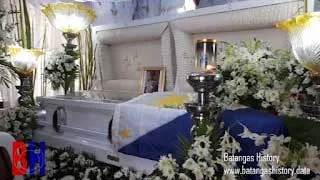5 Strange Batangas Beliefs when there are Deaths in the Family
Not just Batangueños, but many Filipinos will agree that all sorts of strange and obscure beliefs and superstitions come out of the closet when there is a death in the immediate family. Not that there is always an explanation for any of these, and any inquiries are often dismissed by the elderly with an emphatic “Basta!” – probably an indication that they themselves have forgotten how these beliefs and superstitions started in the first place.
From the so-called “historical data” of the towns and barrios of Batangas, we extract some strange and quirky and mostly forgotten beliefs and superstitions regarding deaths in the family. Some have explanations and others do not; and as beliefs and superstitions rather tend to go, they were believed nonetheless.
These “historical data” were compiled and written in the early 1950s – almost 70 years ago – so most of these will have been forgotten by most in the present day. The reader will please bear in mind that Batangas in the era was still largely agrarian in nature, houses were humble dwellings made of basic materials and the state of literacy nowhere near what it is in the present.
1. Going to the Garden after Visiting a Wake
The 2013 movie “Pagpag: Siyam na Buhay” popularized the “pagpag” superstition, which says one should not go straight home after visiting a wake to confuse spirits who might wish to follow one home1. This belief was probably not known in Batangas, since there was no mention of it in any of the "historical data” about the province’s towns and barrios. The closest there is to this is one from the “historical data” of Coliat, Ibaan, which says that one should not go straight to one’s vegetable garden after visiting a wake because doing so will cause the vegetables in the garden to die. Typically, no explanation is given as to why.
2. The Vegetable Taboo
From the “historical data” for the Barrio of Concordia in Alitagtag3, we find this unusual superstition pertaining to the eating of vegetables when there is a death in the family. It says that members of the family of the person who just died should refrain from eating vegetables, especially malunggay, while the corpse is still inside the house. For this belief, an explanation is given. Because vegetables, in the case of the malunggay the leaves, “fall off the stem easily,” therefore eating these will cause more members of the family to die soon. This belief is likewise mentioned with slight variations in the “historical data” for many other towns and barrios in Batangas.
3. Piling Dishes during a Wake
During a wake, and especially on the fourth day according to the “historical data” for the barrio of Sirang Lupa4 in what used to be the town of Batangas, it was prohibited to pile plates one on top of another – presumably to take these to the sink for washing – because “doing so would mean that the members of the family of the deceased would die one after the other within a short duration of time.” This belief is echoed in other historical data about the towns and barrios of Batangas.
4. Pouring Water as the Coffin is Brought Out
From the “historical data” of San Fernando and Santiago in Malvar5, we get this really strange practice of pouring water on the floor as the coffin is brought out and down of the house for interment. To put this in context, houses then typically had floors and a flight of stairs made of bamboo. We presume that the water was poured after the coffin, otherwise the bamboo would have been made slippery. Curiously, from the “historical data” for Barrio Tubigan in Lemery6, it says that a pail of water was poured over the stairs as the coffin was brought out, which would have made it really tricky for the men carrying the coffin. This practice was also done elsewhere in Batangas, although unfortunately, no explanation about why it was so was provided by any of the “historical data.”
5. Keeping Away the “Aswang”
Keeping vigil over the dead is a universal practice, but in some cases in the barrios of Batangas of old, this was done for a reason that those in the present day may even find amusing. The “historical data” for Barrio Dahilig in Lemery7 says that people used to keep vigil over the corpse to protect it from the “aswang” who, it was believed, would be finding a way to steal the dead person’s liver. This practice is likewise mentioned in a few other “historical data” documents for other towns and barrios of Batangas.
2 History and Cultural Life of the Barrio of Coliat,” online at the National Library of the Philippines Digital Collections.
3 “History and Cultural Life of the Barrio (Concordia),” online at the National Library of the Philippines Digital Collections.
4 “History and Cultural Life of the Barrio Sirang Lupa,” online at the National Library of the Philippines Digital Collections.
5 “Collection and Compilation of Historical Data, Barrios of San Fernando and Santiago (Formerly Payapa,” online at the National Library of the Philippines Digital Collections.
6 “Compilation of Historical Data for the Barrio of Tubigan, Municipality of Lemery,” online at the National Library of the Philippines Digital Collections.
7 “Compilation of Historical Data for the Barrio of Dahilig, Municipality of Lemery,” online at the National Library of the Philippines Digital Collections.

